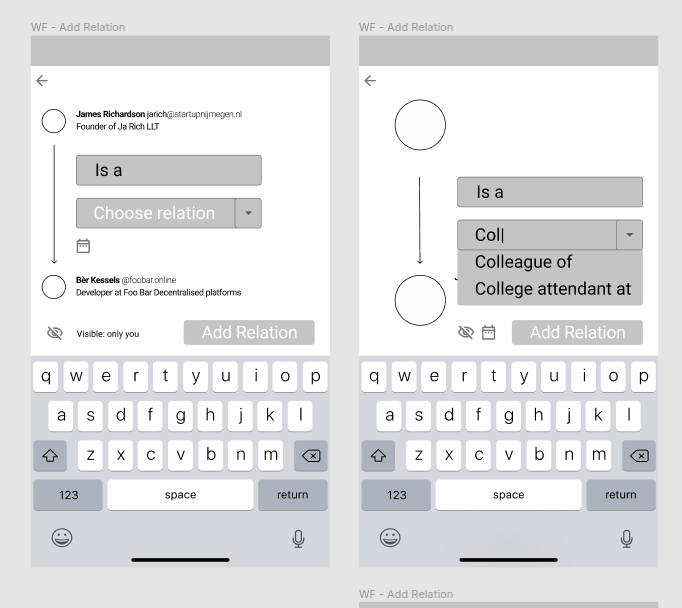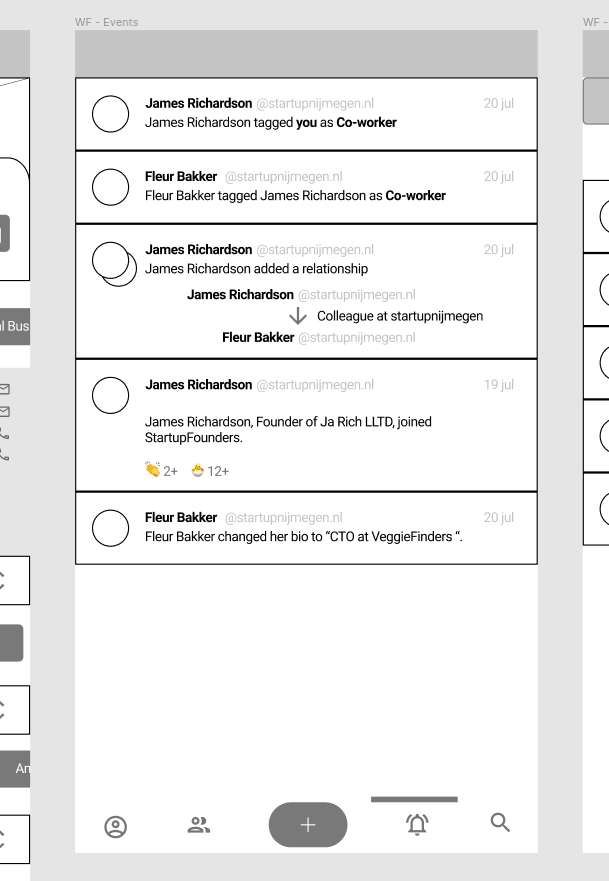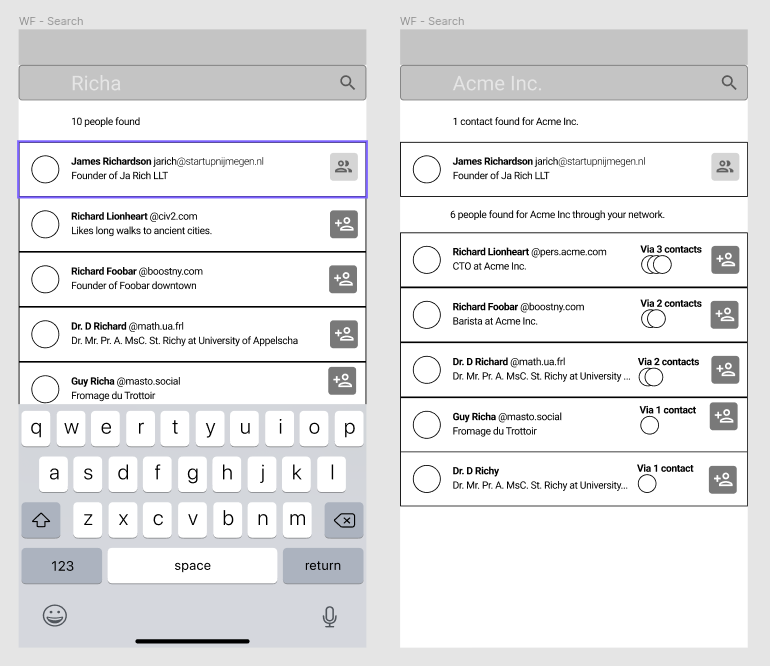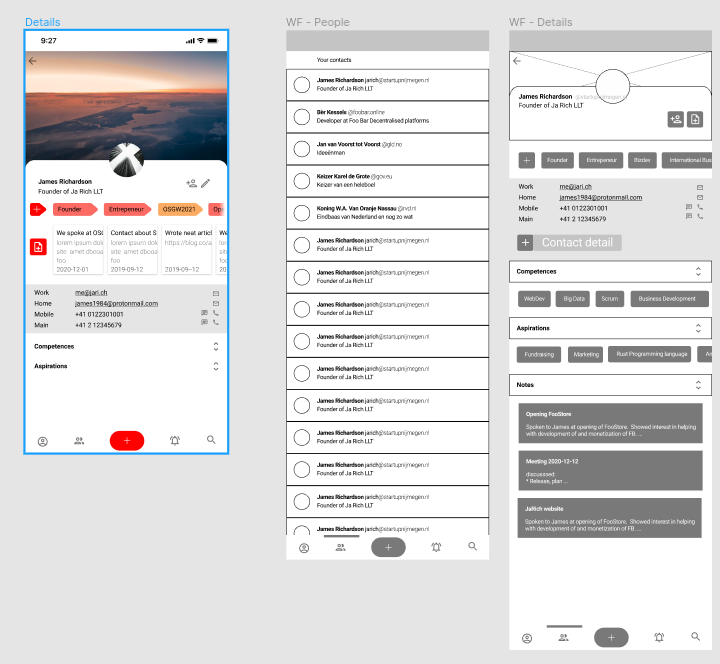Flockingbird is a professional social network. Where you manage your business network. Decentralised, and privacy friendly.
For a tour along the main features, here is the story of Anne, Bob, Carol and Kim. Who find work, find a freelancer, keep in contact, and grow a company.
Any resemblance to companies, brands, domains and people is entirely accidental.
Anne is a Spanish translator, looking for a gig, and Bob is developing an app that needs to be translated to Spanish. Anne is member of opentranslators group wich runs a Flockingbird instance on members.opentranslators.org. Bob is not yet a member of flockingbird, but his colleague Carol is member of gamedevs.online.
Presenting yourself.
In order to be found, Anne wants to present herself professionally. By publishing her résumé, or CV online.
By filling out her profile on members.opentranslators.org, Anne builds a neat looking résumé^1. She tweaks the visibility of her profile and contact details so that her previous translation jobs, her education her work-email and telegram handle are visible to anyone. Her profile is visible at https://members.opentranslators.org/m/@anne@opentranslators.org.
Anne also provides some publicly visible aspirations, one of which is “app-development” and some competences, amongst which, obviously, is “Translate English to Spanish”.

CRM
On the other side of the world Bob uses Hooli Search to look for “Translate English to Spanish Freelancer” and adds “app development” as keywords. A link to https://members.opentranslators.org/m/@anne@opentranslators.org shows up amongst the search results.
Bob likes what he sees, notes the email-address in the contact details and emails Anne about her price and availability. Bob does not use Telegram, so he ignores that contact detail. He also sees that in order to add Anne to his contacts, add a note or tag her, he should provide something called a “flockingbird account”. Knowing Carol uses Flockingbird, he asks Carol to help.
Carol visits Annes profile, adds a note “contacted about translation work on XYZ app” and tags her as “Spanish Translator”, both of which she keeps private for herself only. By adding a note or tagging, Annes profile is added to Carols contacts.
The project is a success and Carol leaves a public note on Anne’s profile as positive review. She also publishes the “Spanish Translator” tag, as endorsement of that competence.
Anne sees this and decides to add Carol as a relation and publishes this. “Anne worked on XYZ with Carol from June to September 2020”. This not only adds Carol to Annes contacts, it shows a rich relation, allowing Anne to organize her contacts through her relation with those contacts.

Keeping in touch.
A few more gigs pass, and Anne hires her first employees. She changes her email-address from anne@neutronmail.com to hi@aviato.trans, so that her emails can be handled by her assistant. She also changes her bio from “Freelance Translator” to “CEO of Aviató, The Translate Company”.
Carol gets a notification that Anne changed her bio. She hits the 👏-button, but decides she wants to congratulate Anne more personally. She opens the contact details and clicks the email-address. Carols own email app opens and has “hi@aviato.trans” filled in: her address-book “magically” updated the email address of Anne.
Through tagging, carol can group and categorise her contacts. By adding notes, she can add reminders, thoughts and reviews on a person. Some of which she can make public, some of which she keeps to herself. And a few of which she only shares with her fellow Game Developers at gamedevs.online.

Finding people.
Bob likes the idea of Flockingbird, so he starts an instance for his startup. He invites his colleagues and adds Anne and Carol as his contacts. When bob is ready to conquer the eastern markets with his app, he searches for “Korean translator” on his own instance. Bob sees that Kim pop up in his search results, because Anne is in his contacts, and Anne has Kim as contact. Bob sees a note left by Anne on Kim’s profile in which Anne is ecstatic about how fast and thorough Kim worked in a previous translate job. Bob decides to add Kim as contact and add a note “TODO: ask if interested in translating XYZ, due: next week”. The “due:” in the note adds a button “add to calendar”, clicking that, allows Bob to add the note and contact details to his favourite calendar app“.

Things that Flockingbird does not do.
Flockingbird does not want to be a typical social network with chat features, timelines, updates and such. We believe that you don’t want another inbox to keep an eye on. Not another medium to interact with people and not another place to post your thoughts and memes.
Your profile links to the places where people can reach you. The profile links to places where people can follow your memes and pictures.
Flockingbird has simple and basic CRM functionality: slightly more than your common address book. But no calendar functionality, appointments, communication-logs and such. We believe that if you need those, there are far better calendars, appointment applications and tools to index your communication with clients in private and secure ways.
And when someone updates their details, that will automatically sync to your local copy in your contacts. You can add your own contact details, tags, notes and such to contacts, to enrich and organize those.
Notifications are kept to a minimum, mostly to notify you that someone did something on your profile (that you are allowed to see): publicly tag you, add a relation, add a public note, etc. And to notify you of important changes in your contacts’ profile. Interaction on those notifications is kept to only leaving a “reaction” in the form of an emoji. We believe that conversations (and thus replies) are best left to social networks and chat or discussion platforms far better suited for this.
All this leaves a lot of room for details to be filled in, we’re full of ideas, such as adding direct “Contact” buttons to contact details you & the other have in common: e.g. add a “chat on matrix” button on Annes profile when both Anna and you have a matrix-handle published. Or smarter notes parsing so that we can integrate even better with existing apps, such as linking to emails sent, or maintaining meeting notes etc. By keeping it simple and allowing as much freedom as possible, we can fill in those features when they arise. Or allow instances to enable those based on their use-case.
Do you see any use-case that we missed? Is there a feature you deem crucial to a “professional social network”, that you think we should consider? Please let us know in the comments below, or with a message on our Mastodon account.
^1 The exact details, design options and are still being defined at time of writing.


Comments
No comments yet. Be the first to react!